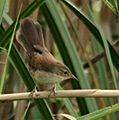Black-capped donacobius facts for kids
Quick facts for kids Black-capped donacobius |
|
|---|---|
 |
|
| In Piraju, São Paulo, Brazil Note lower bird displaying yellow neck patch |
|
| Conservation status | |
| Scientific classification | |
| Genus: |
Donacobius
|
| Species: |
atricapilla
|
 |
|
| All-year range | |
The black-capped donacobius (Donacobius atricapilla) is a lively and loud South American bird. You can find it across the northern half of South America. These birds are easy to spot and hear in their natural homes.
Contents
About the Black-capped Donacobius
The black-capped donacobius is the only bird in its group, called Donacobius. Its scientific name, atricapilla, comes from Latin words meaning "black-haired". This refers to the bird's distinctive black cap. Scientists have studied this bird for a long time. They have learned more about where it fits in the bird family tree.
For many years, scientists grouped this bird with different families. At first, it was thought to be like a thrush. Later, it was moved to the mockingbird family. Some even thought it was a type of wren. But now, most experts agree it belongs in its very own family, called Donacobiidae. This shows how much we learn about animals over time.
Where Black-capped Donacobius Birds Live
Black-capped donacobius birds are common in many wet areas. They live in places like the Amazon Basin. This includes oxbow lakes and riverbanks. They love areas with tall, thick plants growing in or near water.
You can find them in many countries. Their home stretches from Panama and northern Colombia. It goes through Venezuela and into Brazil. They also live in Paraguay and northern Argentina.
How Black-capped Donacobius Birds Behave
Black-capped donacobius birds are known for their strong pair bonds. They mate for life. You can often see pairs sitting together. They like to perch on top of thick plants near lakes or streams. They are active throughout the day.
These birds often sing together in a special way. It's called antiphonic dueting. This means one bird sings a part, and the other immediately sings a response. It sounds like they are having a conversation!
Their family life is also interesting. Young birds, even after they grow up, often stay with their parents. They help raise their younger brothers and sisters. This is called cooperative breeding. It helps the family succeed and grow.
Images for kids



